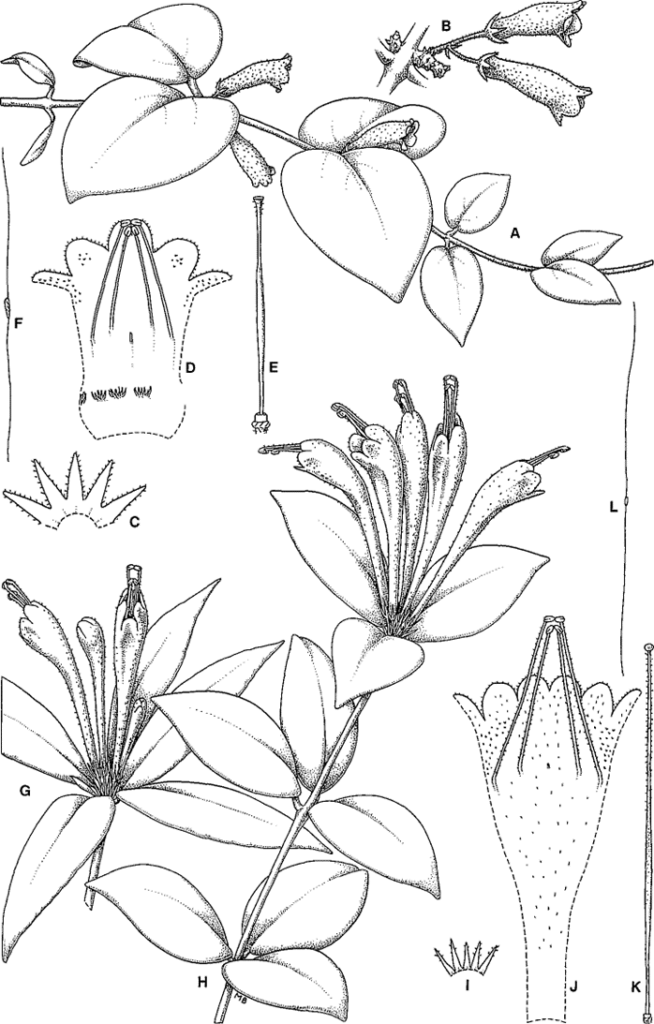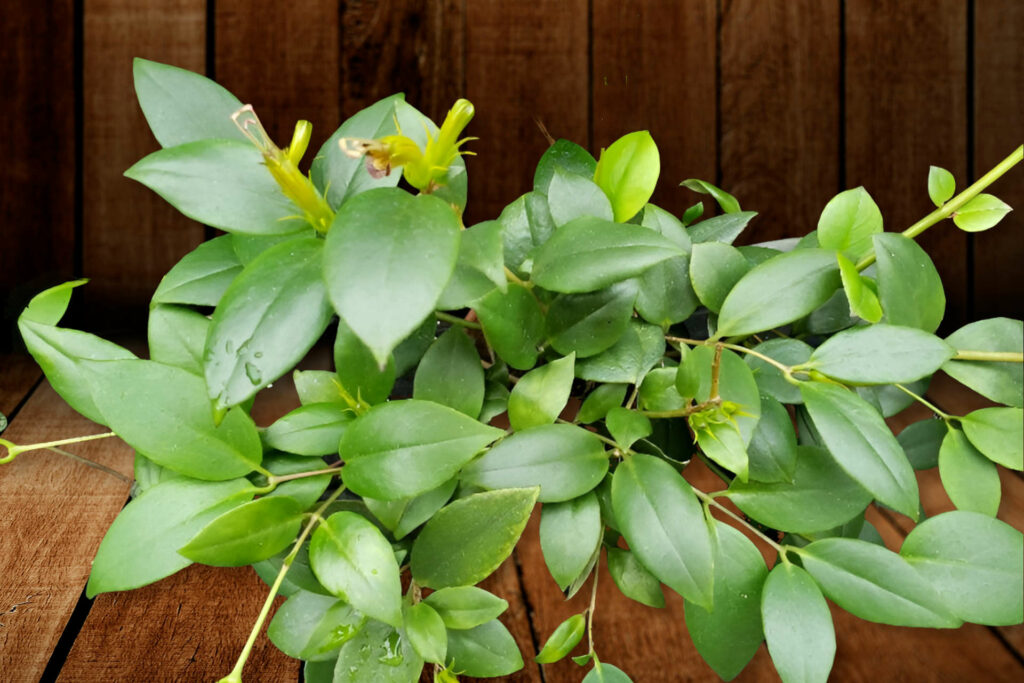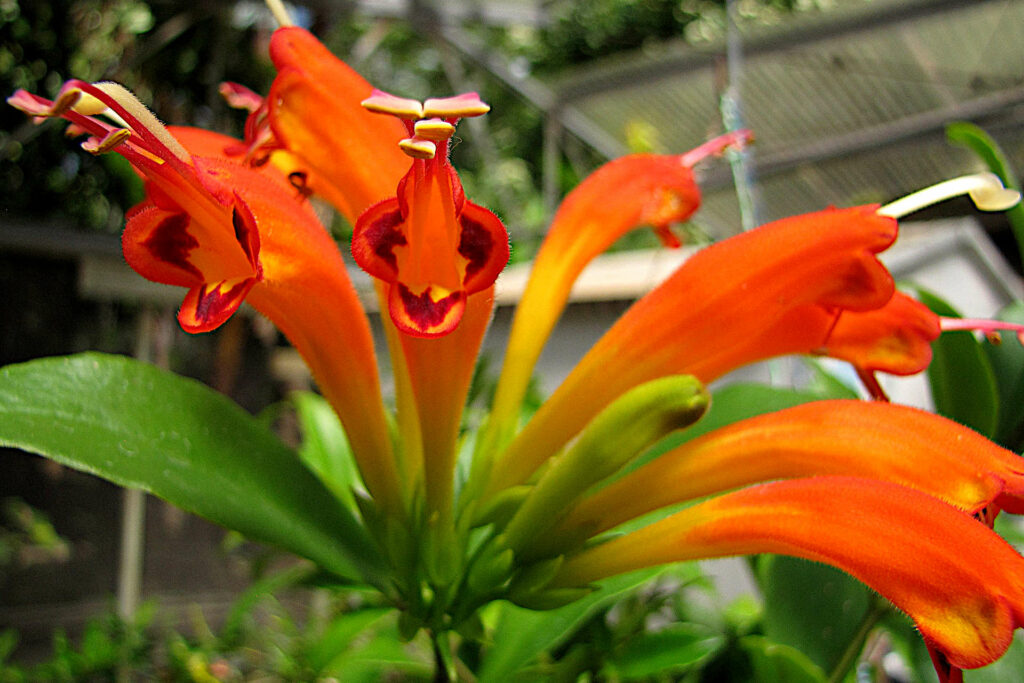The Aeschynanthus Kinabalu and Other New Lipstick Plant Species Recently Discovered
Jess is a true horticulturist whose passion for plants has led her to become an expert in tropical houseplants. Jess was born and raised in...
The genus Aeschynanthus contains over 180 species of tropical plants commonly known as Lipstick plants. These epiphytic plants are native to Asia and are commonly found growing in rainforests. In the late 1990s, several new Lipstick plant Aeschynanthus species were discovered on Mt Kinabalu in Borneo and in the Philippines. One of the new species found on Mt Kinabalu was named Aeschynanthus kinabalu.
These discoveries added to the diversity of Aeschynanthus species already known. The genus is divided into six sections based on seed hair characteristics. Over half of the Bornean Aeschynanthus belong to the section Aeschynanthus. The Philippine Aeschynanthus are less well known, but most appear to be in the section Aeschynanthus as well. The new species Aeschynanthus kinabalu falls into the section Haplotrichium.
This article will provide a general introduction to Aeschynanthus plants before describing the new species' discoveries in detail. The unique features of plants like Aeschynanthus. kinabalu will be covered, along with information on their native habitat and conservation status. Caring for and cultivating these remarkable rainforest plants will also be discussed.
New Species Found on Mt. Kinabalu

Aeschynanthus kinabalu
Aeschynanthus kinabalu is a newly discovered species named after the mountain where it was first collected, Mt. Kinabalu in Sabah, Malaysia. This species belongs to the section Haplotrichium.
Description:
- Epiphytic subshrub with trailing, pendulous stems up to 3m long
- Leaves are opposite, thick, leathery, glossy green above and paler below
- Leaves are 4.3-10.1 x 2-6.1 cm, elliptic to broadly elliptic with rounded to subcordate base
- Flowers are pale pink shading to pale green at base, 1.9-2.3 cm long
- Corolla has tufts of hairs inside about 4mm from base
- Seeds are 0.8mm long with slender 5mm hairs at each end
Location and habitat:
- Found at around 200m elevation
- Native habitat is lowland rainforest in Sabah
- Epiphyte growing on trees along rivers and in shaded areas
Conservation status:
- Only known from type location so likely rare and threatened
- Habitat threatened by logging and conversion to agriculture
- Urgent surveys needed to assess conservation status
Research and taxonomy:
- Discovered in 1980 during botanical survey
- Classified as a new species Aeschynanthus kinabalu in 1999
- Placement in section Haplotrichium confirmed by seed hair morphology
- Relationships to similar species like A. trichocalyx need further study
- Ongoing fieldwork and molecular research required to clarify taxonomy
Other New Bornean Species
Several other possibly new Aeschynanthus species have been collected from Borneo but require additional study before they can be described as distinct species. These include:
- Aeschynanthus sp. nov. A
- Known from a single collection made near Padawan, Sarawak in 1947
- Distinguished by large pale yellow flowers and calyx shape
- Aeschynanthus sp. nov. B
- Collected from several locations in Sabah
- Notable for small red flowers and very narrow twisted leaves
- Aeschynanthus sp. nov. C
- Found on Mt Kinabalu and in Sarawak
- Characterized by large domed flowers densely covered in glandular hairs
Further fieldwork is required to relocate these populations and obtain additional specimens. Ongoing molecular research will also help unravel the taxonomy of these putative new species. Comprehensive monographic revision of the Bornean Aeschynanthus is still needed.
New Species from the Philippines

Several interesting new Aeschynanthus species have also been discovered in the Philippines in recent years. One of these is Aeschynanthus batakiorum, found in Palawan.
Aeschynanthus batakiorum
This new species is notable for its spreading yellowish-green calyx and large flowers relative to others in the section Polytrichium.
Description:
- Epiphytic subshrub with flexible spreading or pendulous stems
- Leaves opposite, variable in size and thickness depending on growing conditions
- Glossy green above, paler below, sparsely hairy when young
- Leaves 3-16.5 x 1.5-5.9 cm, oblong-elliptic to elliptic
- Inflorescences bear 1-2 large fleshy flowers
- Calyx yellowish-green, 2.4-2.5 cm long, lobes spreading
- Corolla 3.9-4.1 cm long, lime green and maroon-purple
- Seeds 2mm long with tuft of hairs up to 2cm at one end
Location and habitat:
- Found in Palawan, Philippines
- Epiphyte on trees along rivers from sea level to 500m elevation
Conservation status:
- Appears restricted to specific habitat
- Threatened by deforestation and habitat degradation
- IUCN Red List assessment recommended
Research and taxonomy:
- Discovered in 1998 during botanical survey
- Classified as a new species, Aeschynanthus batakiorum in 1999
- Relationships to Aeschynanthus asclepioides and Aeschynanthus albidus need study
- Further fieldwork is going to be required to determine the full distribution.
This attractive new species was named in honor of the Batak people who inhabit the Palawan forests where it occurs. Ongoing research and conservation efforts are needed to protect rare species like Aeschynanthus batakiorum.
Other Philippine species
Several other possibly new or poorly known Lipstick plant species have been collected from the Philippines and need further study, including:
- Aeschynanthus sp. nov. D - Distinguished by its long trailing stems and pure white flowers, found in the Babuyan Islands.
- Aeschynanthus sp. nov. E - Collected from Dinagat Island, notable for its branched inflorescences bearing up to 15 flowers.
- Aeschynanthus sp. nov. F - Known only from Sibuyan Island, related to Aeschynanthus speciosus but flowers all yellow without red marks.
Further exploration and collection of specimens throughout the islands along with molecular analysis will help clarify the taxonomy of these species.
Cultivation and Conservation

These are rare plants, and it is important that they and their habitat are protected in order for them to survive and thrive naively.
Obtaining Plants
- Many rare Aeschynanthus species are unavailable commercially
- Specialist societies like the American Gloxinia and Gesneriad Society facilitate exchange among hobbyists
- Botanical gardens may have species in conservation collections
- Collectors may offer Lipstick plant seeds or cuttings gathered during fieldwork
- Always ensure wild-collected plants are legal and sustainably sourced
Conservation Actions
Several actions would help protect these threatened rainforest plants:
- Comprehensive surveys to identify critical habitats
- Protection of remaining primary forest from logging and conversion
- Targeted conservation programs for endangered species
- More species assessed for IUCN Red List status
- Enforcement of CITES regulations for rare species
- Ex situ conservation in botanical gardens
- Public education and involvement of local communities
- Further research on taxonomy, biogeography, and ecology
Many rare Aeschynanthus species are at risk of extinction if their tropical forest habitats continue to be degraded and destroyed. Concerted efforts to study and sustainably conserve these plants will be vital to preserving them for the future.
Final Thoughts
The discovery of new Aeschynanthus species like Aeschynanthus kinabalu and Aeschynanthus batakiorum demonstrates that these tropical Asian forests still hold much hidden botanical diversity waiting to be uncovered. While over 180 species are known so far, ongoing exploration and research continues to reveal previously unknown members of this fascinating genus.
Most new discoveries belong to the sections Aeschynanthus and Polytrichium, reinforcing the importance of these groups within the genus. They also showcase the staggering diversity found within the tribe Trichosporeae. Many aspects of the taxonomy, biogeography and ecology of this mega-diverse tribe remain poorly understood. Molecular analysis promises to bring new insights, but thorough fieldwork across remote areas is still needed to advance discovery.
The new species often exhibit distinctive characteristics setting them apart from their closest relatives. Aeschynanthus kinabalu has unique tufts of hairs inside its flowers, while Aeschynanthus batakiorum is defined by its showy spreading yellowish calyx. Such morphologic specializations result from long evolution in isolation. But human-caused habitat destruction now threatens these irreplaceable lineages before they are even scientifically described.
Safeguarding the exceptional biodiversity of tropical Asia will require a multifaceted approach. Expanded protected areas and enforcement against illegal logging are vital to preserving primary rainforest. Assisted colonization for these plants may become necessary to provide habitat where natural environments have been totally eradicated. Comprehensive inventories and monitoring give vital data to guide conservation priorities. Public education and involvement of indigenous communities in the area will also play key roles in shaping sustainable relationships with nature.
The staggering botanical treasures concealed in Asia's remaining rainforests make their conservation imperative. Each new discovery like Aeschynanthus kinabalu further highlights the urgency of this task. If protected and sustainably managed, these ecosystems can continue fostering evolution and revealing their secrets for centuries to come. The time to act is now, before biological jewels like these vanish completely into extinction.
References
- Edinburgh Journal of Botany Vol 56: Three new species of Aeschynanthus (Gesneriaceae), p.265-272.
Jess is a true horticulturist whose passion for plants has led her to become an expert in tropical houseplants. Jess was born and raised in South East Asia surrounded by lush jungles and lush botanical gardens. This environment prompted her to develop a love for all things green and growing. A move to the UK helped her plant care skills and improved her knowledge Her commitment to her craft and her dedication to her customers has earned her a reputation as one of the best in the business. She continues to inspire others with her love for nature and the environment.Bio Page
More Posts